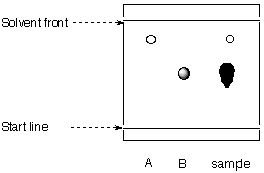
stationary phase:
alumina
mobile phase:
methylene chloride
General Announcement (Please read!)
1.It has come to my attention that some students are not clear about certain policies in this course. There is no such policy in this lab course which discourages students from asking questions. The reason why you are here is to learn. This should also result in questions from the the student's side, which are welcome by the teaching assistants and the instructor. However, it is expected that the student comes prepared to the lab section in order to be able to complete the experiment in a timely fashion. The majority of the questions regarding the experiment (theory and practical issues) can be answered during lecture and office hours. A question generally should demonstrate the student's ability to analyze the problem and be as specific as possible in his/her inquiry.
ATTN: answers to the below questions are due at the start of your lab period; these answers should be part of your pre-lab write-up.
1. Referring to the reaction carried out in the lab, answer the following questions. Show pertinent equations where appropriate.
a. A student uses 95% ethanol for his reaction. What would he observe?
b. What is the function of the potassium hydroxide solution in this reaction?
c. Why is it important to get the solution to a boil before adding the KOH solution?
2. Referring to the recrystallization step, answer the following questions.
a. Why is a solvent mixture used in this step?
b. Which problems does a student face if he boils the mixture used in the lab for a longer time?
c. Why is it unwise to use boiling stones/chips in this step?
d. How is the recovery yield maximized in this step?
3. The researcher is given the following TLC from his assistant, who carries out the following reaction: A + B --> C.
 |
stationary phase: mobile phase: |
a. Calculate the Rf-values for all compounds.
b. Is the reaction above completed?
c. What would change if the student would use hexane instead on methylene chloride?
d. What can be said about the relative polarity of A and B?
4. Student C has to obtain the UV-Vis spectrum for an weakly polar compound. The literature reports the following peaks: 220 (50000), 430 (8000), 550 (500). He is asked to measure the visible range only. (Note: The number in parathesis are the molar extinction coefficients)
a. Which concentration(s) should he use in order to determine the molar extinction coefficient for all peaks in this range?
b. Which solvent would be appropriate here?
c. Which type of cuvette should he use?